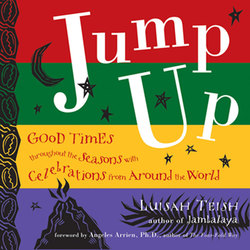Читать книгу Jump Up - Luisah Teish - Страница 7
На сайте Литреса книга снята с продажи.
ОглавлениеPREFACE
Jump Up is a term used as an expression of great joy. Most often it refers to an event that includes joyous music, laughter, food, and dancing. So we may have a Jump Up to celebrate a special occasion. It also refers to the act of dancing with abandon, as we do at Mardi Gras in New Orleans and the Carnivals of Brazil, Jamaica, and San Francisco. Jump up is a relative of several other joyous expressions. In celebration we find ourselves jumping, jamming, swinging, hopping, and kicking it.
Whether it is an event or an action, jump up always implies an outward expression of inner joy. This joy comes not merely from a set of circumstances, such as the decorations or the food, but is an outpouring of a feeling that resides deep within a person, a community, or a culture.
All the spiritual cultures of the world have holidays that are designed to celebrate our relationship to Spirit, to Nature, and to each other. On these occasions we recognize that we are children of the Earth responding to changes in the Earth by participating in celebrations of the seasons. We also acknowledge the life and work of illustrious ancestors who have given us the culture we've inherited and the celebrations we observe. This book helps us to celebrate the seasons and these ancestors. It is written for people who want to feel themselves a part of the larger family and community of the world.
This year, as in every year, many of us will find satisfaction in repeating ceremonial acts that have been prescribed by our culture and religion for centuries. Some of us will honor the ways of the past but may also find that the familiar celebrations have lost their meaning, or that the meaning has become obscured by gross commercialism. We may find that we have a need for something that goes deeper, that is more personal and more directly related to our desires and experiences.
This book is written for the person who wants to understand the meaning of traditional holidays such as Christmas and Easter. By examining the mythology and the symbolism of these holidays, you will come to understand the meaning of Yule logs and rabbits who peddle chicken eggs. We will go into the depth of the past, and the celebrations will become more meaningful to you. We will come to know what our ancestors knew and how these celebrations came to be.
The traditional holidays are based on earlier celebrations of the Equinoxes and the Solstices, which charted the movement of the Sun and its relationship to life on Planet Earth. Winter officially begins with the Solstice on December 21. It is the longest night of the year. Thereafter, night diminishes and day increases until they are equally balanced at the Spring Equinox. On March 21, day begins to increase and continues its ascendancy until June 21—the Summer Solstice, the longest day of the year. Then the Sun yields its power until night and day are equal again, at the Autumn Equinox on September 21. This cycle is the Joyous Dance of Winter, Spring, Summer, Autumn, Winter, and Spring again. This is the Natural Cycle of gestation, growth, fullness, and harvest. How these are celebrated in Western culture will be explored.
Perhaps a greater gift of this book is to introduce the reader to a wide variety of celebrations from many cultures in the world. We will participate in the African American celebration of Kwanzaa, the Mexican celebration of Diá de Los Muertos (Day of the Dead), and the Chinese celebration of Mooncakes and Hungry Ghosts. You will meet the deities of Africa, Europe, Asia, and the Americas who helped shape the natural world. The trees that inhabit the rainforest and the animals that roam the plains will play with you, and the ancestors of ancient times will tell you their stories. Then you will be encouraged to explore the beautiful landscape of your own dreams and desires, and from that deep place to create celebrations that are truly meaningful and joyous.
A Calendar is provided at the end of the book, so that you may tune in to the celebrations that are happening somewhere in the world every day. And, if you wish, you can participate with them in your own home.
In each chapter I share the stories of my personal travels. I invite you to come with me on a camel ride across the Giza plateau in Egypt, to climb up the rocks and then down into a cave in Jamaica, and to jump up with me in an African village. In this way I can share the continuing adventures of my quest for joy and kinship. By sharing these experiences we can jump up around the globe. You will mingle with the people, feel their joy, and share in their mystery.
At the end of each chapter you will find examples of celebrations I have conducted in diverse communities with great success. Here you will find guidelines for creating your own celebrations.
And because food, like music, is such an important part of the celebration, I have made at least one serving suggestion for each season and have included recipes. Some will be familiar to you; others come from cookpots in foreign corners of the world. I have also listed a few cookbooks where other recipes can be found.
So pull out the cloth and the candles, bake the bread and arrange the flowers, gather together, then go deeply into the beauty of Nature and contemplate the mystery of Spirit, and when you emerge from the deep, put on the music and jump up.
